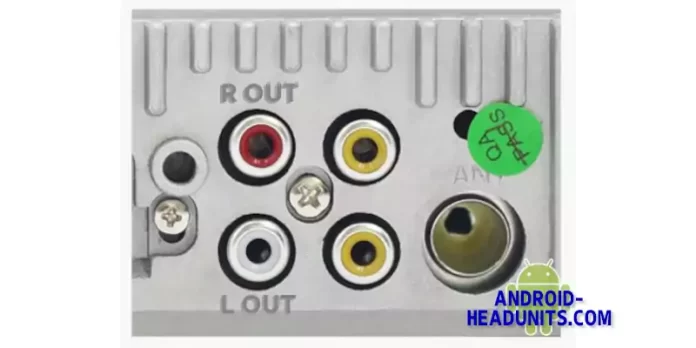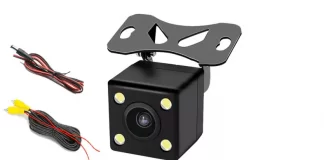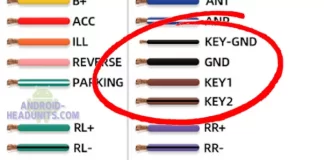You can often find L_OUT and R_OUT connectors on an Android headunit. The two RCA sockets, one Red and the other White. They may be two RCA sockets on the stereo’s body or two flying leads with nothing connected. Other times, they are labeled AUX_AUDIO_OUT_L and AUX_AUDIO_OUT_R or other permutations to denote an auxiliary audio output with an L (LEFT) and (R) RIGHT stereo channel pair.
But what are they for?
and
How do you connect them?
AUX
Aux is for auxiliary, an additional, supplemental connection. It is not a mandatory connection, but it is there if you want to expand the system beyond its standard capabilities.
L is for LEFT, R is for RIGHT
These are the Left and Right channels of the stereo sound. There are two parts to stereo sound playback: Left and Right, L for the Left Channel and R for the Right Channel.
Connecting the left and right channels correctly will ensure the stereo image is delivered to the speakers on the correct side. This will more closely reproduce the stereo sound as it was intended to sound when recorded.
Red is for R, and White is for L
The RCA/Phono Outputs are often colored red (Right Channel) or white (Left Channel) to differentiate them from the video signals carried on the yellow plugs and sockets.
OUT
Out denotes an output. This is the sound signal coming from the stereo and designed to be fed to something externally, and that something is usually an amplifier.
Speakers
If you have connected your speaker wires to the car speakers, you won’t have anything to connect to the RCA L_OUT or RCA R_OUT. This is correct, and you don’t use both the speaker connections and the L_OUT / R_OUT. This is an either/or situation.
Line Level
The R_OUT and L_OUT are at a line level; this is a low-voltage sound output. Such a low power output needs to be amplified to be heard. This is how you connect an amplifier to the Android headunit. Use the line level output to an external amplifier and then connect your car speakers to the amplifier.
Advantages of using L_OUT and R_OUT
The line level of the L and R OUT connections bypass the internal amplification stage of the stereo. This lets you add a better, dedicated amplification stage to your Android headunit. The final amp stage of the Android stereo can make a big difference to the sound you hear. Upgrading this to anything will be better at driving your speakers while taking heat away from the Android headunit internal amp, as this would not be used.
Connect L OUT and R OUT to Amp
Typically, the line level outputs (L_OUT and R_OUT) on the Android car stereos are RCA-type female connectors. Also called Phono sockets, these all have the same corresponding male plug. The most common lead for these is the male RCA to male RCA. This will match with the female RCA on the amplifier and the female RCA on the radio and link the two together.
Mandatory
You do not need to connect R_OUT and L_OUT to anything, and you can use the speaker wires to connect the Android car stereo to the speakers. But if you want to connect an amplifier, you need to disconnect the speakers from the stereo and connect them to the amplifier instead. These amplifier connections will be marked R_IN and L_IN or RIGHT_IN and LEFT_IN or something similar and the same RED and WHITE markers.
Only 2 OUT?
There are only two outputs for the RCA low-level connections: R_OUT and L_OUT. The speaker connections on the ISO connector or factory plug can connect to 4 speakers. The Android stereo has its fader (front to rear balance) circuit in its internal amplifier. If you bypass that internal amplifier circuit, you are back to just the left and proper channels. It will now become the job of the external amplifier to fade the front and rear speakers, and how this will be achieved will all be specific to the amplifier you have.








If I wanted to use a cheap android head unit to supply Internet Radio line out to my quality home hifi, are there any issues? The benefit is that my elderly parents can reliably control a head unit, but not a windows laptop.
* As it avoids the internal amplifier, would the sound be reasonable even with an el cheapo head unit?
* Could I expect issues with power supply (or other) noise in a quiet household setting?
* Are vehicle and household line levels the same?
*As it avoids the internal amplifier, would the sound be reasonable even with an el cheapo head unit?
Yes, this will work.
*Could I expect issues with power supply (or other) noise in a quiet household setting?
A good quality 12v DC power supply of around 2-3 amps will be ok. Pick a qood quality PSU, not a cheap Chinese wall charger.
*Are vehicle and household line levels the same?
Yes, you won’t have any problems there.